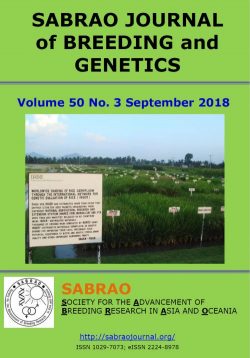Tag Archive maize

SABRAO JOURNAL of BREEDING and GENETICS Volume 50 Number 3 SEPTEMBER 2018
This September 2018 issue covers articles on rice, maize, soybean, mango, shallots, olive, and cereals.
VOLUME 49 ISSUE 3; September 2017
On this volume, studies are on maize, rice, wheat, peanut, Karanda, and mangosteen.
SABRAO Journal Volume 48 Issue 2 June 2016
In this issue, articles are on wheat, cassava, maize, indian mustard, eggplant, rice, rape seed, etc.
SABRAO Journal Volume 47 Issue 4 December 2015
This final issue for 2015 contains articles on tomato, jatropha, rice, maize, linseed, pea, lentil, fenugreek, rice, etc
SABRAO Journal Volume 47 Issue 3 September 2015
This issue for 2015 has articles on sesame, okra, cotton, rice, barley, bitter gourd, maize and Indian mustard in Sudan, Myanmar, and India.
SABRAO Journal Volume 47 Issue 1 March
This first issue for 2015 has articles on cabbage, wheat, corn, tomato and coriander.
MAIZE RESPONSE TO FALL ARMYWORM (SPODOPTERA FRUGIPERDA) AND ASIAN CORN BORER (OSTRINIA FURNACALIS) IN THE PHILIPPINES
M.T. CAASI-LIT and A.M.D. MARMETO
SUMMARY
Philippine traditional maize has long existed for hundreds of years, facing and coping with continuous threats of different pests and diseases, with Asian corn borer and fall armyworm as the most damaging insect pests. Developing resistant varieties can employ rich genetic resources, as these varieties may have likely adapted to these biotic stresses. The development of ACB-resistant varieties proved successful with the Bt corn introduction; however, the attempt to breed for resistance to FAW is still underway. The two insect pests belong under the same Order, and cross-resistance between these pests may be possible. In this study, several traditional maize varieties underwent screening for resistance to ACB and FAW through larval survival on leaf-feeding assay. Among the accessions observed, three variants of APN 0120 (Silangan) and three other traditional maize (APN 0397, APN 0913, APN 0938) showed intermediate to high resistance toward FAW leaf damage. Few of these resistant varieties showed negative to Bt introgression. The most notable is the variant SI of APN 0120, with high resistance to ACB and FAW and low larval weight, without the presence of Bt. A previous report stated the original collection of this accession have potential ACB resistance, although Bt-introgressed. On the other hand, APN 0397 (Lagkitan), introgressed with Bt Cry1Ab, expressed dual resistance to ACB and FAW, too. It elucidates the reaction and potential of previously screened ACB-resistant varieties against FAW and the efficiency of Cry1Ab against FAW. It also demonstrates the potential of the traditional maize as source of germplasm to be explored to promote the utilization of open-pollinated varieties with inherent insect resistance. Moreover, this paper establishes massrearing procedures and laboratory techniques for effective fall armyworm-resistance screening using excised leaf method.
Keywords: Asian corn borer, bioassay technique, fall armyworm, host plant resistance, insect resistance, Philippine traditional maize
Key findings: Eight variants of Philippine traditional maize APN 0120 and two other conventional varieties showed potential resistance to ACB leaf feeding. In addition, three APN 120 variants and three more traditional maize exhibited possible fall armyworm leaf-feeding resistance. Dual resistance to both insect pests took notice on a few entries.
Download this article
Date published: December 2022
DOI: http://doi.org/10.54910/sabrao2022.54.5.24
Genetic diversity among the Philippine traditional maize (Zea mays L.) populations based on SSR markers.
P.R. GUEVARRA, J.F. PARIL, R.R. GARDOCE, A.M. SALAZAR, and A.O. CANAMA-SALINAS
Summary
This paper reports the first genetic diversity analysis of Philippine traditional maize populations performed through a cost-effective DNA pooling strategy. The diversity among selected 100 traditional maize populations collected from Luzon, Visayas, and Mindanao was evaluated using twenty simple sequence repeats (SSR) markers at the Institute of Plant Breeding, University of the Philippines Los Baños, Laguna, Philippines. A total of 138 bands ranging from two to 12 bands per primer were detected. The average number of polymorphic alleles, polymorphism rate, effective multiplex ratio, marker index, resolving power, and expected heterozygosity are 6.283, 87.17%, 5.798, 4.104, 15.897, and 0.658, respectively. The polymorphism information content (PIC) varied between 0.141 to 0.848, with an average value of 0.620. A dendrogram was constructed with a dissimilarity coefficient ranging from 0.14 to 0.55 and a mean dissimilarity index of 0.425. Cluster analysis revealed 13 groups based on the result of Approximately Unbiased (AU) p-values from 10,000 bootstrap iterations. The cluster analysis enabled the classification of populations with ambiguous places of origin. Analysis of molecular variance (AMOVA) showed higher within-population diversity (70%) than among-population diversity (30%) with PhiPT (pairwise genetic differentiation metric) of 0.298 (P = 0.001). These results revealed the significant diversity of traditional maize populations in the Philippines and the power of SSR markers in diversity and cluster analyses despite the age of this marker technology. These findings will aid plant breeders in developing approaches towards knowledgeable and efficient execution of breeding programs using traditional maize populations.
Download the article
Date published: September 2022
Keywords: Traditional maize, Philippine germplasm, cluster analysis, SSR markers, AMOVA, bootstrapping
DOI: http://doi.org/10.54910/sabrao2022.54.3.1